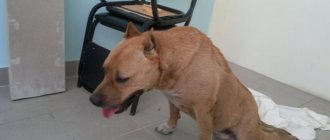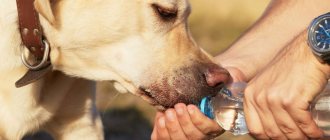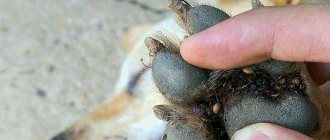Anastasia Dmitrievna Mitryaykina
veterinarian Petstory
Blood in a dog's stool (hematochezia) is a frightening symptom that dog owners encounter not as rarely as they would like. This can be diarrhea in a dog with blood, or bleeding without diarrhea. There are many reasons for this condition, some of them do not pose a threat to life, while others can lead to the sudden death of the animal. It is important to distinguish between these situations, provide first aid correctly and contact a veterinary clinic in a timely manner.
- Parvovirus enteritis
Blood in a dog's stool: the main thing
If we see scarlet blood in a dog's stool, it is most likely from the intestines or from the anal area. Blood from the stomach almost always gives a dark (black) color to the stool.
Blood visible to the eye in a dog’s stool may appear due to:
- Infections: canine parvovirus enteritis, canine coronavirus enteritis, leptospirosis, canine distemper, rotavirus, food toxic infection (salmonellosis, clostridiosis, campylobacteriosis, listeriosis, yersineosis, botulism).
- Poisoning (poisoning with drugs used for deratization and medicines is especially dangerous).
- Gross violation of diet - eating sharp bones, unusual food, gluttony. Intestinal injuries from swallowing a foreign object, injuries to the anal area.
- Neoplasm (tumor) of the intestine.
- Injuries or neoplasms (adenomas, less commonly adenocarcinomas, mastocytomas) in the anal area.
- IBD (a group of idiopathic inflammatory bowel diseases).
The owner's first actions
Before visiting the veterinarian, you can try to stop the bleeding with folk remedies. Nettle or chamomile decoction is suitable for this. A decoction of oak bark will help cope with bacteria.
The consequences of intoxication can be eliminated with sorbents: activated carbon, Enterosgel or Polysorb. In addition to flushing out toxins, they can firm up the stool. Rice water will also cope with this.
To reduce the load on the gastrointestinal tract, put your pet on a starvation diet. If you maintain your appetite, eat soft and light foods. If the animal eats dry food, soak the granules with water.
Manifestations
Bloody diarrhea in dogs
Such a symptom is certainly life-threatening and indicates the need to seek veterinary help as soon as possible, regardless of what the cause was.
Blood in stool of normal consistency
If a dog poops blood while feeling well, with normal frequency of bowel movements, density and volume of feces, then, as a rule, this indicates a chronic problem or its exacerbation.
Associated signs indicating the disease
Sometimes red pigments in stool appear when eating red food, and in females during estrus, then no treatment is needed and the color of the stool returns to normal over time.
However, the following symptoms indicate more dangerous diseases:
- refusal to eat, weakness;
- diarrhea or vomiting;
- shallow rapid breathing;
- cough or discharge from the nose or eyes;
- pungent odor from stool, presence of mucus in it;
- lump in the abdomen;
- pallor of the mucous membranes;
- dry skin;
- exhaustion.
These symptoms are especially dangerous for puppies and small breed dogs, as they do not tolerate dehydration well. If any gastrointestinal ailments occur, you should immediately contact a veterinary clinic. If there is delay, the dog may simply not live to determine the causes of the disease and the onset of the disease.
Causes of blood in dog stool
Parvovirus enteritis
The most common infection that occurs with bloody diarrhea is parvovirus enteritis. Typically, parvovirus enteritis is manifested not only by the dog going to the toilet with blood, but also by severe vomiting, refusal to feed, lethargy, and fever.
Other infections
Canine distemper can cause not only blood in a dog's stool, but also other symptoms: conjunctivitis, pneumonia, fever.
Other infections (canine coronavirus enteritis, leptospirosis, rotavirus, food poisoning - salmonellosis, clostridiosis, campylobacteriosis, listeriosis, yersineosis, botulism), of course, can also occur in a dog with loose, bloody stools, but more often the symptoms will be less pronounced, especially in the first days of illness.
Food poisoning
Foodborne illness can be caused by eating excessively bacterially contaminated foods; it manifests itself as acute vomiting and diarrhea, often with blood. The main toxic infections are salmonellosis, campylobacteriosis, clostridiosis, and less commonly listeriosis, yersineosis, and botulism.
Poisoning
Bloody diarrhea can be caused by poisoning - for example, household chemicals, rodent control drugs.
Some medications, if the dosage regimen is not followed or individual sensitivity, can provoke bloody diarrhea (for example, non-steroidal anti-inflammatory drugs, glucocorticosteroids).
Parasitoses
Parasitosis (helminth infections, protozoan infection of a dog) can also cause bloody diarrhea in a dog or cause small streaks of blood to appear in stool of normal consistency.
Associated symptom
A small amount of scarlet blood in the stool during diarrhea in a dog is probably a secondary symptom (trauma to the vessels of the rectum, anus, with a painful urge to defecate); here, first of all, it is necessary to stop the diarrhea by promptly establishing its cause.
Neoplasms and injuries of the intestine and perianal area
The reason for the appearance of blood from the anus without diarrhea in a dog may be injury or a neoplasm (tumor) in the anal area, a diet violation (for example, feeding bones), the dog swallowing non-food items, diarrhea or constipation of any etiology, poisoning, infections, parasitosis (helminthic invasion).
Injury in the anal area can be caused by accident or be a consequence of self-trauma - for example, with itching in the perianal area (blockage of parallel glands, post-gumming dermatitis).
Neoplasms in the intestine can be represented by adenomas, adenocarcinomas, leiomyosarcoma, and less commonly other tumors. As a rule, at the stage when the tumor begins to bleed, we are already talking about its disintegration, and the prognosis ranges from cautious to unfavorable. Benign tumors of the hepatoid glands are usually found in the anal area, but they can cause many problems, since the area is “dirty” and they often ulcerate.
IBD
A group of idiopathic inflammatory bowel diseases that includes lymphoplasmacytic enteritis or gastroenteritis, eosinophilic colitis or gastroenterocolitis, and rarely granulomatous enteritis and enterocolitis.
The diagnosis is made by exclusion and confirmed histologically.
Main causes of gastrointestinal bleeding
Dilatation of hemorrhoidal veins of the rectum
The pathogenesis of the disease involves dilatation of the veins of the lower parts of the rectum, which leads to the rupture of one or more small veins and the release of blood. As a rule, bleeding occurs after defecation or physical activity; the patient notices the release of several drops of scarlet blood on the stool, underwear or toilet paper. There may also be copious bleeding, which may indicate a ruptured hemorrhoid.
The mechanism of bleeding in hemorrhoids is associated with mechanical damage to the dilated veins of the lower rectum by passing feces or as a result of increased pressure in them during straining or physical activity. Typically, such bleeding does not cause pain in the patient, however, when an anal fissure forms or its complication occurs in the form of paraproctitis, pain is present during and after defecation. Less commonly, frequent hemorrhoidal bleeding can lead to the initial stages of anemia with all its manifestations.
With the progression of hemorrhoids and the absence of adequate treatment, the size of the nodes gradually increases, bringing increasing anxiety to the patient, and more often they become traumatized, complicated by bleeding of various volumes. If you suspect the presence of hemorrhoids, you should urgently visit a proctologist, because timely treatment of the disease will prevent the development of its complications.
Rectal fissures
Hemorrhoids as a cause of anal bleeding
This disease develops as a result of the mechanical impact of dense feces on the wall of the rectum, in which a rupture of varying length is formed, and as a result, bleeding. The patient notices the discharge of scarlet blood immediately after defecation or during it, as well as sharp pain when feces pass through the area of the rectum with a crack.
Diagnostics
When an owner notices blood from their dog's anus, they should definitely seek veterinary help.
At the appointment, the doctor will first interview the owner and conduct a detailed examination of the animal.
Hurry up, choose a box and find out what gift awaits you
Discount on pet insurance
Promo code copied to clipboard
The doctor will assess the general condition, the degree of dehydration (turgor, moisture of the external mucous membranes), and the degree of blood loss. Thermometry, auscultation, palpation and percussion of the abdominal organs will be carried out (the doctor will listen, touch, tap on the patient’s stomach). It is possible that an on-site test will be performed to determine bleeding time and blood clotting rate (this may require “scratching” the dog), and a rectal examination.
Depending on the severity of the case, after examination, additional diagnostic measures may be required to make a diagnosis:
- A general clinical blood test will be required to accurately determine the degree of blood loss, the presence of inflammation, and make a decision on prescribing antibiotics.
- A biochemical blood test can help determine how the internal organs cope with the problem.
- Tests for infections (blood samples can be taken to detect antibodies to infections or rectal washings to detect the antigen - the cells of the pathogen themselves).
- Microscopy of a native rectal smear can be performed to detect helminth and protozoan eggs.
- Ultrasound examination of the abdominal cavity makes it possible to see the shape, size, structure of internal organs, assess the patency and peristalsis of the intestine, and detect neoplasms and foreign objects.
X-ray examination allows you to visualize the topography, volume and structure of internal organs, and detect radiopaque foreign bodies. Sometimes it is also indicated to give the animal a radiopaque substance (for example, barium sulfate), it stains the feeding tube, and it becomes possible to visualize a problem that was previously hidden. This method also allows you to assess the speed of passage of a food coma and detect complete or partial obstruction and intussusception.
Treatment
Treatment, of course, depends on the cause of the appearance of blood in the dog’s stool, the severity of the patient’s condition, concomitant pathologies, age and many other factors.
After assessing the animal’s current condition and carrying out diagnostic procedures, the doctor either begins treatment immediately, or chooses outpatient treatment, or, if the patient’s condition allows, postpones prescribing therapy until the test results.
If the dog’s condition is severe, significant blood loss, anemia, and dehydration are detected, then the doctor conducts intensive therapy. This may be oxygenation, infusion therapy, transfusion of blood or its components, or surgery. If the bleeding time and clotting rate tests are poor, or if there are multiple bleeding spots, rodenticide (rodent control) poisoning is suspected. In such a situation, the use of an antidote is required - vitamin K1 (konakion, caject). It is important to remember that in case of poisoning with an unknown rodenticide, therapy must be continued for 4-6 weeks, because that is how long modern poisons against rodents can be active in the animal’s body.
If the appearance of blood in a dog’s stool is caused by an infection, then the doctor, having prescribed symptomatic treatment and correction of the condition immediately, prescribes etiotropic therapy based on the test results.
If a traumatic foreign body or a voluminous neoplasm is detected in the intestine, then surgical treatment is most likely required - immediately or after stabilization of the condition.
If the cause of detection of blood in the stool is parasitosis or protozoan infection, then specialized treatment is prescribed.
Diet correction is necessary if feeding disorders are the cause of the problem.
Types of bleeding
If the gastrointestinal tract is disrupted, blood may appear in the animal's stool. The discharge may vary in appearance and color. It depends on the nature of the damage to the dog’s body.
Usually, bleeding is divided into two large groups based on color:
- The color is red, scarlet corresponds to secretions that have retained their structure and have a state close to natural. Such blood is called native. Bleeding usually occurs in one part of the intestine.
- The color is brown, dark, comparable to coffee grounds, they have secretions that have interacted with enzymes. This may indicate problems with the animal's esophagus, stomach, or initial intestine.
Blood in puppy's stool
Blood in a puppy's stool can occur for the same reasons as in an adult dog. But in the first place here will be parvovirus enteritis and other infections, helminthic infestations, but neoplasms, if they occur in puppies, are extremely rare.
If you notice that your puppy is pooping blood, especially if it is accompanied by diarrhea, then you should contact the clinic immediately, because puppies are very difficult to tolerate dehydration and the risk of the pet’s death is enormous.










